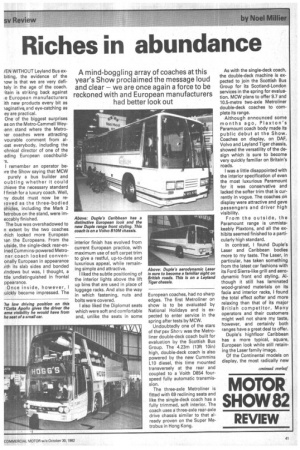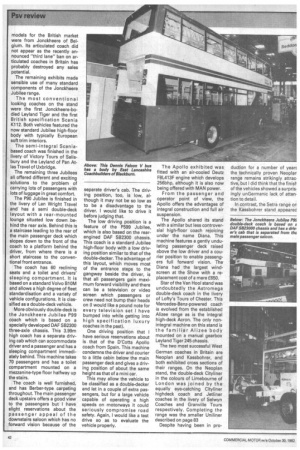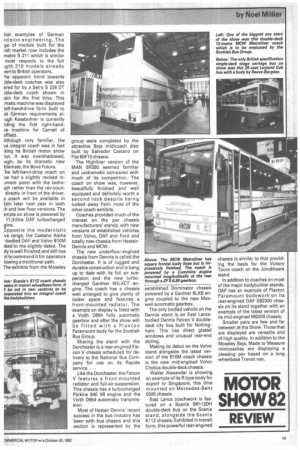Riches in abundance
Page 31

Page 32

Page 33

If you've noticed an error in this article please click here to report it so we can fix it.
/EN WITHOUT Leyland Bus exbiting, the evidence of the low is that we are very defitely in the age of the coach. itain is striking back against le European manufacturers ith new products every bit as laginative, and eye-catching as ey are practical.
One of the biggest surprises as on the Metro-Cammell Weyiann stand where the Metroler coaches were attracting vourable comment from alost everybody, including the Ichnical director of one of the ading European coachbuilds.
I remember an operator be;re the Show saying that MCW purely a bus builder and oubting whether it could 3hieve the necessary standard f finish for a luxury coach. Well, ny doubt must now be reloved as the three-bodied ehicles, including the Mark 2 letrobus on the stand, were imeccably finished.
The bus was overshadowed to n extent by the two coaches thich looked more European Ian the Europeans. From the utside, the single-deck rear-enined Cummins-powered Metroner coach looked convenonally European in appearance tith its slab sides and bonded iindows but was, I thought, a ttle undistinguished in frontal ppearance.
Once inside, however, I luickly became impressed. The interior finish has evolved from current European practice, with maximum use of soft carpet trim to give a restful, up-to-date and luxurious appeal, while remaining simple and attractive.
I liked the subtle positioning of the interior lights above the lift up bins that are used in place of luggage racks. And also the way in which fastening, nuts and bolts were covered.
I also liked the Diplomat seats which were soft and comfortable and, unlike the seats in some European coaches, had no sharp edges. The first Metroliner on show is to be evaluated by National Holidays and is expected to enter service in the spring after tests by MCW.
Undoubtedly one of the stars of the psv Sho',v was the Metroliner double-deck coach built for evaluation by the Scottish Bus Group. The 4.23m (13ft 10in) high, double-deck coach is also powered by the new Cummins L10 diesel, this time mounted transversely at the rear and coupled to a Voith D854 fourspeed fully automatic transmission.
The three-axle Metroliner is fitted with 69 reclining seats and like the single-deck coach has a fully trimmed, soft interior. The coach uses a three-axle rear-axle drive chassis similar to that already proven on the Super Metrobus in Hong Kong. As with the single-deck coach, the double-deck machine is expected to join the Scottish Bus Group for its Scotland-London services in the spring for evaluation. MCW plans to offer 9.7 and 10.5-metre two-axle Metroliner double-deck coaches to complete its range.
Although announced some months ago, Plaxton's Paramount coach body made its public debut at the Show. Coaches on display, on DAF, Volvo and Leyland Tiger chassis, showed the versatility of the design which is sure to become very quickly familiar on Britain's roads.
I was a little disappointed with the interior specification of even the most luxurious Paramount for it was conservative and lacked the softer trim that is currently in vogue. The coaches on display were attractive and gave passengers and driver high visibility.
From the outside, the Paramount range is unmistakeably Plaxtons, and all the exhibits seemed finished to a particularly high standard.
In contrast, I found Duple's Laser and Caribbean bodies more to my taste. The Laser, in particular, has taken something from the latest car fashions with its Ford Sierra-like grill and aerodynamic front end styling. Although it still has laminated wood-grained materials on its facia and interior racks, I found the total effect softer and more relaxing than that of its major British competitor. Many operators and their customers might well not share my taste, however, and certainly both ranges have a great deal to offer.
Duple's highfloor Caribbean has a more typical, square, European look while still retaining the Laser family image.
Of the Continental models on display, the most radically new models for the British market were from Jonckheere of Belgium. Its articulated coach did not appear as the recently announced "third lane" ban on articulated coaches in Britain has probably destroyed any sales potential.
The remaining exhibits made sensible use of many standard components of the Jonckheere Jubilee range.
The most conventional looking coaches on the stand were the first Jonckheere-bodied Leyland Tiger and the first British specification Scania K112. Both vehicles featured the now standard Jubilee high-floor body with typically European soft trim interiors.
The semi-integral Scaniabased coach was finished in the livery of Victory Tours of Salisbury and the Leyland of Pan Atlas Travel of Uxbridge.
The remaining three Jubilees all offered different and exciting solutions to the problem of carrying lots of passengers with lots of luggage in great comfort.
The P90 Jubilee is finished in the livery of Len Wright Travel and has a semi double-deck layout with a rear-mounted lounge situated low down behind the rear axle. Behind this is a staircase leading to the rear of the main passenger deck which slopes down to the front of the coach to a platform behind the driver, from where there is a short staircase to the conventional front entrance.
The coach has 60 reclining seats and a toilet and drivers' sleeping compartment. It is based on a standard Volvo B1OM and allows a high degree of fleet standardisation and a variety of vehicle configurations. It is classified as a double-deck vehicle.
More obviously double-deck is the Jonckheere Jubilee P99 coach which is based on a specially developed DAF SB2300 three-axle chassis. This 3.99m high coach has a separate driving cab which can accommodate driver and a passenger and has a sleeping compartment immediately behind. This machine takes 70 passengers and has a toilet compartment mounted on a mezzanine-type floor halfway up the stairs.
The coach is well furnished, and has Berber-type carpeting throughout. The main passenger deck upstairs offers a good view to the passengers but I have slight reservations about the passenger appeal of the downstairs saloon which has no forward vision because of the separate driver's cab. The driving position, too, is low, although it may not be so low as to be a disadvantage to the driver. I would like to drive it before judging that.
The low driving position is a feature of the P599 Jubilee, which is also based on the rearengined DAF SB2300 chassis. This coach is a standard Jubilee high-floor body with a low driving position similar to that of the double-decker. The advantage of this layout, which moves most of the entrance steps to the gangway beside the driver, is that all passengers gain maximum forward visibility and there can be a television or video screen which passengers or crew need not bump their heads on (I would like a pound note for every television set I have bumped into while getting into high specification luxury coaches in the past).
One driving position that I have serious reservations about. is that of the D'Cotta Apollo coach from Spain. This machine condemns the driver and courier to a little cabin below the main passenger deck and gives a driving position of about the same height as that of a mini car.
This may allow the vehicle to be classified as a double-decker and let in a couple of extra passengers, but for a large vehicle capable of operating a high speeds on motorways it could seriously compromise road safety. Again, I would like a test drive so as to evaluate the vehicle properly. F8L413F engine which develops 256bhp, although it is also now being offered with MAN power.
From the passenger and operator point of view, the Apollo offers the advantages of integral construction and full air suspension.
The Apollo shared its stand with a similar but less controversial high-floor coach rejoicing under the name Diana. This machine features a gently undulating passenger deck raised above the low driver and a courier position to enable passengers full forward vision. The Diana had the largest windscreen at the Show with a replacement cost of a mere £650.
Star of the Van Hool stand was undoubtedly the Astromega double-deck coach in the livery of Lofty's Tours of Chester. This Mercedes-Benz-powered coach is evolved from the established Alizee range as is the integral high-deck Acron. The only nonintegral machine on this stand is the familiar Alizee body mounted on a manual gearbox Leyland Tiger 245 chassis.
The two most successful West German coaches in Britain are Neoplan and Kassbohrer, and both exhibited cross sections of their ranges. On the Neoplan stand, the double-deck Cityliner in the colours of Limebourne of London was joined by the equally eye-catching Cityliner highdeck coach and Jetliner coaches in the livery of Selwyn Coaches and Granville Tours respectively. Completing the range was the smaller Uniliner described on page 83
Despite having been in pro
duction for a number of years the technically proven Neoplan range remains strikingly attractive, but I did think that the finish of the vehicles showed a surprisingly unGermanic lack of attention to detail.
In contrast, the Setra range on the Kassbohrer stand appeared ical examples of German acision engineering. The ge of models built for the :ish market now includes the metre S 211 which is similar most respects to the full igth 215 models already iwn to British operators.
he apparent trend towards able-deck coaches was also ered for by a Setra S 228 DT Able-deck coach shown in rain for the first time. This matic machine was displayed left-hanthdrive form built to ,st German requirements al'ugh Kassbohrer is currently 'ding the first right-handve machine for Carnell of 3ffield.
klthough very familiar, the va integral coach was in fact king its British motor show nit. it was overshadowed, iugh, by its dramatic new blemate, the Bova Futura.
The left-hand-drive coach on )vv had a slightly revised inument panel with the tachoiph rather than the rev-coundirectly in front of the driver. a coach will be available in tam n later next year in both lh and low floor versions. The ample on show is powered by 11.3-litre DAF turbocharged gin e.
Dpposite the modernistic va range, the Caetano Alpha '-bodied DAF and Volvo B1OM aked to me slightly dated. The dy is well finished and still has pt to commend it for operators lowing a traditional path.
Ihe exhibits from the Moseley group were completed by the attractive Beja midicoach also built by Salvador Caetano on Fiat 6010 chassis.
The Highliner version of the MAN SR280 seemed familiar and undramatic compared with much of its competition. The coach on show was, however, beautifully finished and well equipped and definitely worth a second look despite being tucked away from most of the other coach exhibits.
Coaches provided much of the interest on the psv chassis manufacturers' stands, with new versions of established vehicles from Volvo, DAF and Ford and totally new chassis from HeatairDennis and MCW.
The new underfloor-engined chassis from Dennis is called the Dorchester. It is of rugged and durable construction and is bang up to date with its full air suspension and the new turbocharged Gardner 6HLXCT engine. The coach has a chassis well arranged to give plenty of locker space and features a front-mounted radiator. The example on display is fitted with a Voith D854 fully automatic gearbox and after the show will be fitted with a Plaxton Paramount body for the Scottish Bus Group.
Sharing the stand with the Dorchester is a rear-engined,Falcon V chassis scheduled for delivery to the National Bus Company for use on its Rapide service.
Like the Dorchester, the Falcon V features a front-mounted radiator and full-air-suspension. This chassis has a turbocharged Perkins 640 V8 engine and the Voith D854 automatic transmission.
Most of Hestair Dennis' recent success in the bus industry has been with bus chassis and this section is represented by the established Dominator chassis powered by a Gardner 6LXB engine coupled to the new Maxwell automatic gearbox.
The only bodied vehicle on the Dennis stand is an East Lancsbodied Dennis Falcon V doubledeck city bus built for Nottingham. This has direct glazed windows and unusual rear-end styling.
Making its debut on the Volvo stand alongside the latest version of the B1OM coach chassis is the new mid-engined Volvo Citybus double-deck chassis.
Walter Alexander is showing an example of its R type body for export to Singapore, this time mounted on Mercedes-Benz 0305 chassis.
East Lanes coachwork is featured on a Scania BR112DH double-deck bus on the Scania stand, alongside the Scania K112 chassis, Exhibited in transit form, this powerful rear-engined chassis is similar to that providing the basis for the Victory Tours coach on the Jonckheere stand.
In addition to coaches on most of the major bodybuilder stands, DAF has an example of Plaxton Paramount bodywork on its rear-engined DAF SB2300 chassis on its stand together with an example of the latest version of its mid-engined MB200 chassis.
Smaller psvs are few and far between at the Show. Those that are displayed are versatile and of high quality. In addition to the Moseley Beja, Made to Measure minicoaches are displaying a pleasing psv based on a long wheelbase Transit van.






































































